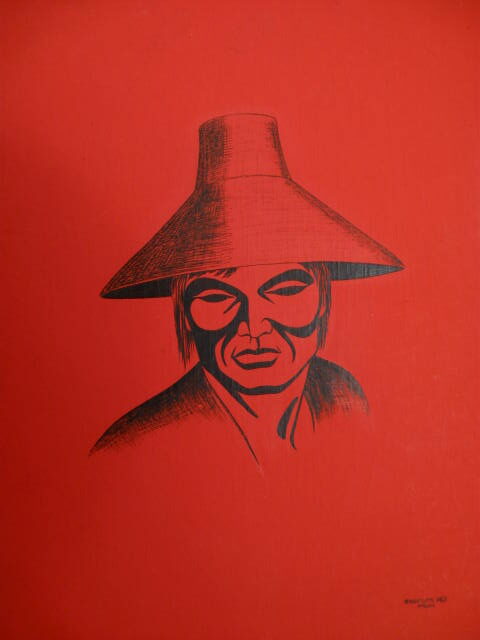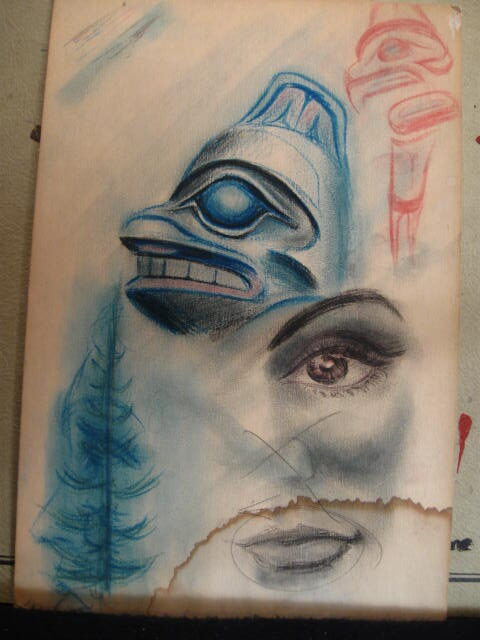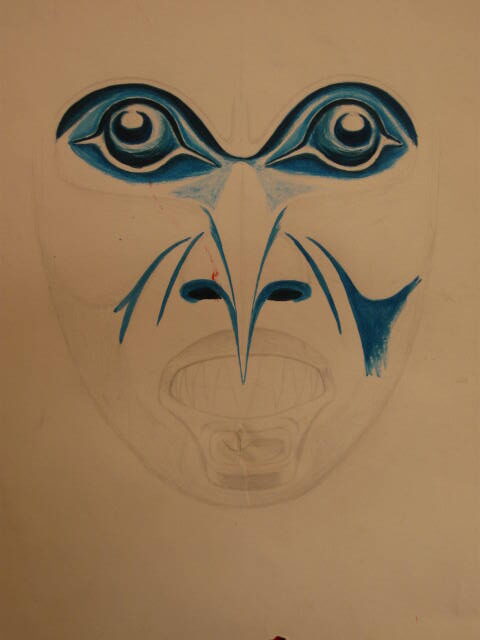HAIDA MASTER CARVER AND PAINTER PATRICK SAMUEL MCGUIRE – TWO SIGNED SKETCH PADS 1968
Pat McGuire experimented in these 2 sketch pads while painting 2 long dugout canoes at the Fraser River in Queensborough B.C. during the summer of 1968.
Large sketch pad 18” x 12” – 46 cm x 30 cm – 3 pages with sketches plus loose page with fine Eagle designs.
Small sketch pad 14”x 11” – 35 cm x 28 cm with the blind fisherman painted against a red background (front cover) plus 4 pages with sketches, plus 2 loose pages with sketches.
HISTORY
Haida Artist Patrick Samuel McGuire- June 5 1943 -December 11 1970
Skidegate – Haida Gwaii – Formerly Queen Charlotte Island B.C
Patrick McGuire, member of the Staastas Eagle Clan, was born one of five children to a Haida mother and to a Ontario born father of Ojibway and Irish heritage. Descendant of the master carver Charles Gladstone and distantly related to the great Haida artist Charles Edenshaw.
Young Pat was first taught by his uncle Joe Tulip in Skidegte British Columbia.
At the age of 19 Pat McGuire moved to Vancouver, B.C. There Pat and also the young Haida artist Robert Davidson, were inspired by Haida master carver Bill Reid.
In 1966 Professor Bill Holm of the Thomas Burke Memorial Washington State Museum published his epic book Northwest Coast Indian Art- An Analysis of Form. This well illustrated study book sparked a cultural revival of Northwest Coast Indian Art. Pat and Robert were the first in a new generation of many talented fine young artists representing Northwest Coast Indian Art.
The storm swept islands of Haida Gwai originally were the centre of development of Northwest Coast Art. The warrior Haidas in their huge red cedar dugout canoes were known as the Vikings of the North Pacific. However since the arrival of the first white seafarer Capt. George Dixon who named the islands after his ship in 1787, a string of tragic events took place including the small pox epidemic of 1860, the introduction of alcohol and the attempted cultural genocide by the church and state. An example of the culture destruction included the burning of over 25 sacred Totem Poles as ordered by the missionaries in Masset and Yan. Further, in 1884 the Federal Government amended the 1880 Indian Act to include the statement that “Every Indian or other person who engages in or assists in celebrating the Indian festival known as ‘Potlatch’ or in the Indian dance known as ‘Tamanawas’ is guilty of a misdemeanour and shall be liable to imprisonment”.
Pat McGuire was a survivor of the infamous Indian Residential School System and this cultural destruction where children were punished for only uttering a few words in their mother tongue.
While in Vancouver, the handsome young Pat McGuire soon drew the attention of museums, dealers and collectors with his unique North West Coast art work. Pat was a perfectionist: he would destroy any of his works of art before he would sell something that failed to meet his standards. Pat’s most common artworks were his beautiful argillite medallions which became a popular jewellery item. Pat was able to turn out several pieces each night (his favourite time to work). Pat’s striking water color drawings show that he was working within the framework of the rigidly observed rules of Northwest Coast Art. For example Pat’s works exemplify the swelling and constricting black form line delineating each design unit which is typical of Northwest Coast Art. Further examples include the flowing lines without any square corners, the characteristic heavy curved black eyebrows, the large eye sockets, and the split designs.
Pat’s style was distinctive with amazingly clean and sweeping lines reminiscent of Charles Edenshaw.
While observing the strict protocol of genuine Northwest Coast designs, Pat McGuire was also an innovator. Pat was first to add realism upon the traditional form lines by applying effective shadowing and drawing human like hair with precise accuracy. Pat portrayed raw emotion in the faces that he drew. The realism of his art is in harmony with tradition, the mesmerizing eyes and the way he painted cheekbones is unique.
It is not commonly known that Pat McGuire also worked on a very large project in the summer of 1968. Pat was commissioned to paint 2 sea going dugout canoes for a would be movie production. Both canoes were later acquired by Eric Harvie for his Glenbow Museum Collection in Calgary Alberta. Pat painted a door with the Raven Story as well. Pat kept a couple of sketch books, of which some pages are shown here.
One page shows the “Blind fisherman” against a red background. The photos show Pat working on the half finished canoes. And both completed canoes being paddled in the Fraser River during the movie shoot.
Pat McGuire sadly only lived to be 27 years old. But during that brief time, he produced master pieces of extraordinary vitality, a living memorial to his legacy.
Once again magnificent Totem Poles are being erected in Pat’s homeland Haida Gwaii.
Perhaps someday a pole will be raised in memory of Patrick Samuel McGuire.







![7[5309]](https://ethnographicantiquestore.com/wp-content/uploads/2023/04/75309-680x457.jpg)
![10[5315]](https://ethnographicantiquestore.com/wp-content/uploads/2023/04/105315-680x543.jpg)
![8[5307]](https://ethnographicantiquestore.com/wp-content/uploads/2023/04/85307-680x462.jpg)
![9[5316]](https://ethnographicantiquestore.com/wp-content/uploads/2023/04/95316-680x679.jpg)






![7[5309]](https://ethnographicantiquestore.com/wp-content/uploads/2023/04/75309-100x100.jpg)
![10[5315]](https://ethnographicantiquestore.com/wp-content/uploads/2023/04/105315-100x100.jpg)
![8[5307]](https://ethnographicantiquestore.com/wp-content/uploads/2023/04/85307-100x100.jpg)
![9[5316]](https://ethnographicantiquestore.com/wp-content/uploads/2023/04/95316-100x100.jpg)








